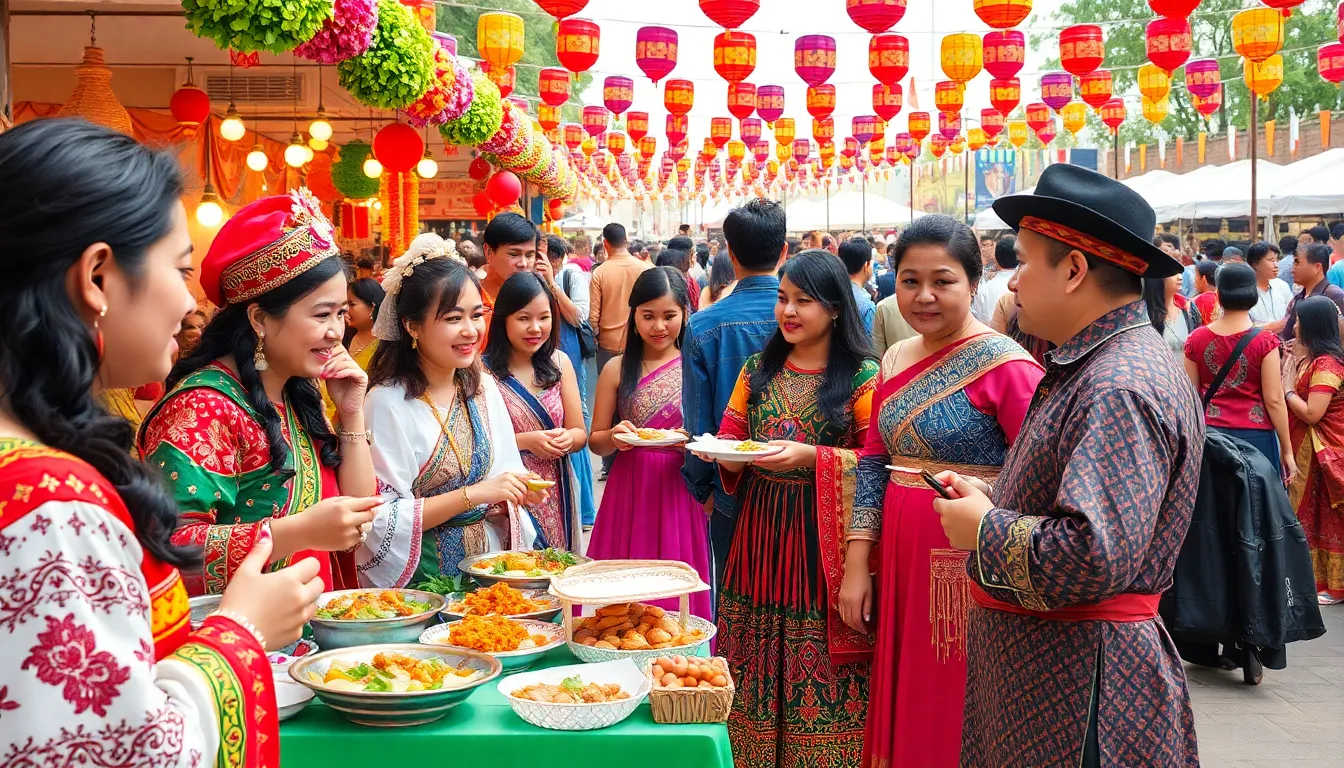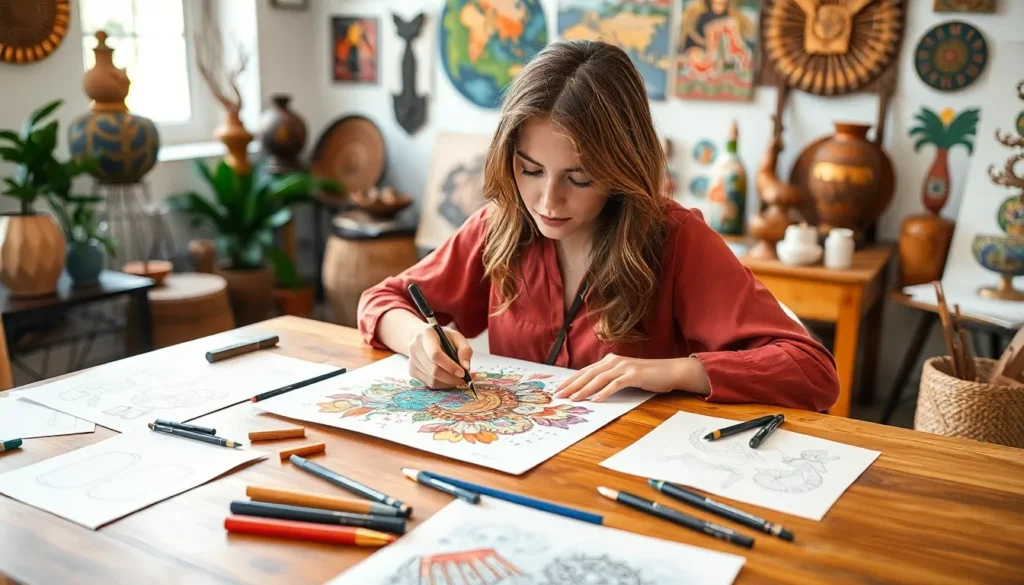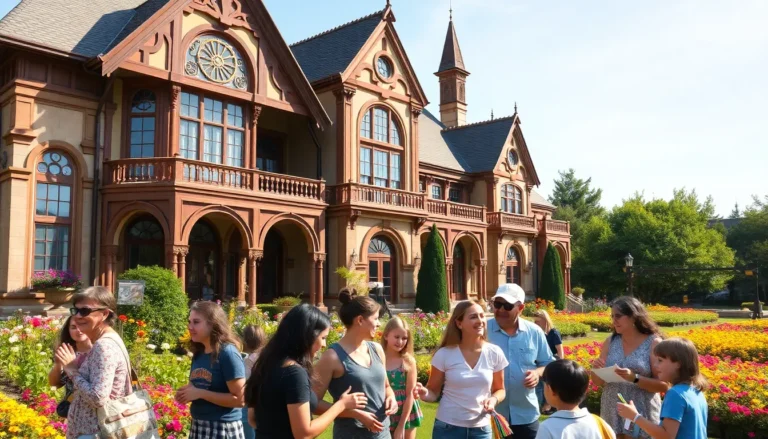Table of Contents
ToggleCultural diffusion drawing isn’t just an artistic endeavor; it’s a vibrant tapestry of ideas, traditions, and influences that crisscross the globe. Imagine a world where your doodles can spark a conversation about ancient civilizations, modern trends, and everything in between. This unique form of expression allows artists to blend styles and stories, creating a visual feast that’s as enlightening as it is entertaining.
Whether you’re a seasoned artist or a curious beginner, diving into cultural diffusion drawing opens up a world of creativity. It’s like mixing your favorite flavors in a smoothie—unexpected combinations can lead to delightful results. So grab your sketchpad and let’s explore how this dynamic art form can transform your perspective, one stroke at a time. Who knew that drawing could be both fun and a passport to the world’s cultures?
Understanding Cultural Diffusion
Cultural diffusion refers to the process through which cultural elements, such as ideas, beliefs, and practices, spread from one society to another. This exchange often leads to the enrichment of cultures, transforming both the origin and recipient societies in the process.
Definition of Cultural Diffusion
Cultural diffusion is the transfer of cultural elements between groups. Examples include the spread of language, art styles, and culinary practices. This transfer can occur through various means, such as trade, migration, and cultural interactions. Each time people encounter new ideas, they adapt and integrate them into their own cultural frameworks. This continuous exchange fosters diversity while preserving original cultural identities.
Importance in Society
Cultural diffusion plays a crucial role in shaping societies. It enhances creativity and innovation by combining different cultural perspectives. Diverse influences can lead to new art forms, technological advancements, and social practices. This intermingling of cultures promotes understanding, tolerance, and mutual respect among groups. Societies benefit significantly by embracing cultural diffusion, leading to enriched social dynamics and collective advancement.
The Process of Cultural Diffusion

Cultural diffusion includes various methods to share and integrate cultural practices, enhancing both individual and collective experiences across societies.
Methods of Cultural Diffusion
Exchange of goods often serves as a primary vehicle for cultural diffusion. Trade introduces new ideas and practices as different cultures interact. Migration allows people to carry their customs, beliefs, and artistic expressions to new locations, facilitating cultural enrichment. Cultural interactions, such as festivals and public gatherings, create opportunities for direct engagement, enabling shared experiences that foster deeper understanding. The rise of technology plays a significant role in modern diffusion, as social media and digital communication allow diverse cultures to reach each other rapidly.
Examples of Cultural Diffusion
Culinary arts provide a prominent example of cultural diffusion. Dishes from various countries blend flavors and techniques, creating unique fusion cuisines that reflect mixed heritages. Music also showcases cultural diffusion; genres like jazz and reggae incorporate elements from different traditions, leading to rich musical landscapes. Fashion trends illustrate another facet of this process, with styles crossing borders and evolving as people adopt and adapt them. Art movements, such as Impressionism, draw inspiration from global influences, reshaping aesthetic values and techniques in painting.
Cultural Diffusion Drawing Techniques
Cultural diffusion drawing techniques utilize a variety of methods to express the blending of diverse cultural influences. Exploring these techniques can enhance an artist’s understanding and representation of different traditions.
Tools and Materials Needed
Artists require several tools and materials for cultural diffusion drawings. Graphite pencils facilitate initial sketches, while fine-tipped pens enable detailed line work. Watercolors or acrylic paints offer vibrant options for color application. Mixed media supplies, such as collage elements from different cultures, add unique texture. Additionally, sketchbooks or high-quality paper provide suitable surfaces for various techniques. Artists also benefit from reference images that showcase cultural elements to inspire creativity.
Step-by-Step Guide to Creating a Cultural Diffusion Drawing
Creating a cultural diffusion drawing follows a straightforward process. First, gather inspiration from various cultures, focusing on symbols or motifs relevant to each. Next, draft a preliminary sketch that incorporates these elements harmoniously. After finalizing the sketch, outline with a fine-tip pen for clarity. Then, apply colors thoughtfully, ensuring they reflect the original inspirations. Finally, add details and textures to enhance depth. Display the completed artwork prominently, inviting discussions about the interconnectedness of cultures.
Analyzing Cultural Diffusion Drawings
Cultural diffusion drawings invite observation and analysis to uncover various influences. Identifying the cultural symbols, motifs, and themes within these artworks reveals the rich tapestry of ideas that shape each piece. Look for colors that signify specific cultures, patterns that reference traditional art forms, and figures that represent community or history.
What to Look For
Examine cultural symbols, as they often embody deeper meanings tied to specific traditions. Recognize colors that resonate with particular cultures, enhancing emotional and aesthetic appeal. Note patterns that reveal artistic styles, connecting different historical contexts. Also, observe figures that tell stories or convey messages, shedding light on shared human experiences. Each element contributes to a comprehensive understanding of the artwork’s significance.
Interpretations and Themes
Artworks often reflect themes of unity and diversity, showcasing the beauty of cultural blending. Consider how conflicts and resolutions between cultures manifest in the drawings, illustrating the complexity of human interactions. Identity can also play a crucial role, as artists explore their own cultural backgrounds through their work. Themes of migration highlight the continuous exchange of ideas, emphasizing how cultures adapt and evolve over time.
Cultural diffusion drawing stands as a powerful medium for artistic expression that transcends borders. By blending diverse influences, artists not only create visually captivating works but also foster understanding and appreciation of various cultures. This practice encourages exploration and innovation, inviting individuals to experiment with their creativity.
As artists engage with the rich tapestry of global traditions, they contribute to a dialogue that celebrates unity and diversity. The resulting artworks serve as a testament to the beauty of cultural exchange, highlighting the importance of collaboration and shared experiences in shaping a vibrant artistic landscape. Embracing cultural diffusion in drawing opens up endless possibilities for connection and inspiration.







